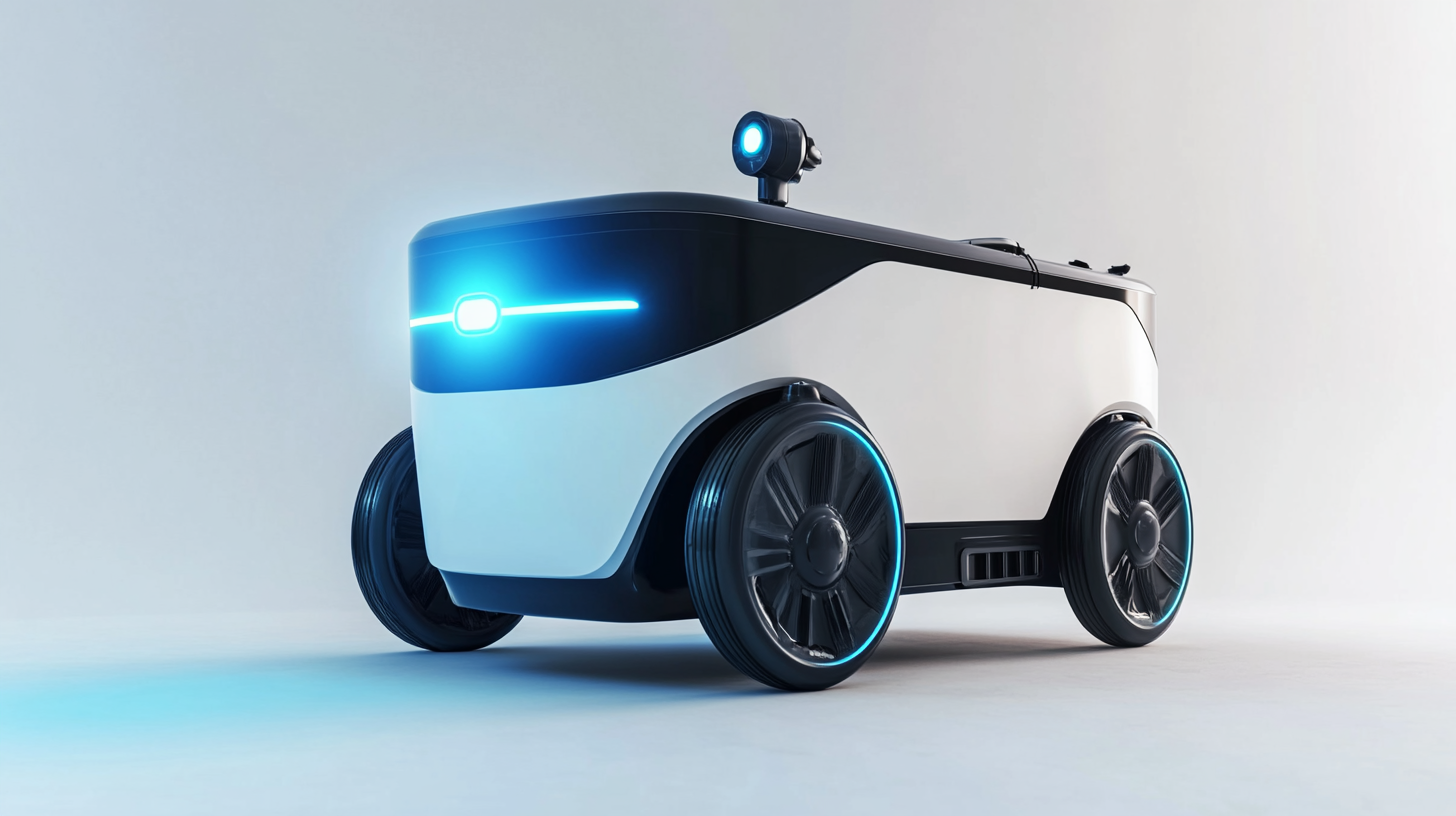

14, Raghava Enclave, Transport Road, Secunderabad, Hyderabad (500009)
©2024 All Rights Reserved by excitechrobot.com
In recent years, the advent of technology has revolutionized global supply chains, leading to remarkable enhancements in efficiency and productivity. Among these technological advancements, Autonomous Robot Projects are emerging as game-changers, transforming the way goods are transported, stored, and managed. These innovative projects are not only streamlining operations but also addressing challenges such as labor shortages and the rising cost of logistics, ultimately paving the way for a more resilient and automated supply chain ecosystem.
As businesses seek to adapt to an ever-complex global market, the integration of autonomous robots presents a solution that combines speed, precision, and reliability. From warehouse automation to last-mile delivery, these sophisticated machines are designed to operate with minimal human intervention, navigating various environments and optimizing workflows. This blog will explore some of the most innovative Autonomous Robot Projects currently being implemented in supply chains worldwide, showcasing how they are enhancing operational capabilities and setting new standards for the future of logistics.

The evolution of supply chain management is increasingly influenced by innovative technologies that drive the deployment of autonomous robots. As industries face the urgency for efficiency and resilience, mobile robots and drones are emerging as transformative assets in logistics operations. Their adoption is not merely a trend but a reflection of maturity in technology that enables companies to enhance productivity and streamline workflows. Autonomous robots are being employed for a variety of tasks, ranging from inventory management to last-mile delivery. These advancements facilitate real-time tracking, reduce human error, and optimize resource allocation. As robots navigate through warehouses and retail spaces, they help in maintaining stock levels and ensuring timely deliveries, which are crucial in today’s fast-paced market environment. Moreover, automated systems are designed to work collaboratively with human employees, augmenting their capabilities rather than replacing them. In environments where repetitive tasks can lead to fatigue, robots serve as supportive tools, allowing workers to focus on more strategic activities. This synergy not only boosts operational efficiency but also contributes to job satisfaction as employees engage in more meaningful work. The continued progress in robotics and automation points to a future where supply chains become not just smarter but also more adaptable, ultimately enhancing customer experiences across the globe.

In recent years, the implementation of autonomous robots within global supply chains has surged, showcasing significant advancements in efficiency and productivity. According to a report by McKinsey, over 50% of companies have incorporated robotics technology in some capacity, highlighting the rapid adoption of these innovations. Prominent case studies illustrate how businesses across various sectors have successfully leveraged autonomous robots to optimize their operations.
For instance, a major components manufacturer in Germany implemented autonomous mobile robots (AMRs) to streamline warehouse logistics. The robots handle tasks such as inventory management and item retrieval, resulting in a 30% reduction in operational costs and a 40% increase in order accuracy. This transformation not only enhanced overall efficiency but also allowed workers to focus on higher-value tasks, reinforcing the importance of automation in today’s competitive market.
Another exemplary case can be found in the retail sector, where a large grocery chain in the United States deployed robot-powered inventory systems. These robots autonomously navigate aisles to track stock levels, assess product displays, and report discrepancies in real-time. A study by Gartner revealed that retailers utilizing such technology saw a 20% improvement in inventory turnover rates, significantly boosting profit margins. This trend underscores how autonomous robots are becoming integral in maintaining optimal supply chain operations, providing a competitive edge in the increasingly dynamic retail space.
These successful implementations serve as a testament to the potential of autonomous robots to revolutionize supply chains. As technology continues to evolve, the likelihood of increased adoption across industries indicates a promising future for automation, ultimately reshaping how global supply chains operate.

The deployment of autonomous robots in logistics presents a host of challenges that must be addressed to realize their full potential. One of the primary obstacles is the integration of these robots into existing supply chain systems, which often rely on legacy infrastructure. For successful implementation, businesses need to invest in upgrading their technology and ensuring seamless communication between robotic systems and traditional operations. This requires strategic planning and collaboration across departments to redesign workflows and optimize capacity.
Another significant challenge is safety and reliability. Autonomous robots must navigate complex environments filled with human workers and other machinery, necessitating robust safety protocols to mitigate risks. Incorporating advanced sensors and real-time data analytics can enhance decision-making capabilities and allow robots to react appropriately to dynamic situations. Training staff to work alongside these robots is also imperative, fostering an environment of cooperation instead of competition.
Moreover, the substantial upfront costs of deploying these technologies can be a barrier for many companies. However, innovative financing models and partnerships can alleviate this burden. By exploring collaborative robotics—where humans and machines share responsibilities—businesses can optimize their operations and gradually phase in automation. This adaptability can lead to significant long-term cost savings and increased efficiency in global supply chains, ultimately enhancing competitiveness in the market.

The evolution of autonomous robotics in global supply chains is a transformative journey marked by technological advancements and increasing integration into everyday operations. As the demand for speed and efficiency grows, companies are turning to innovative robotic solutions that can streamline processes, reduce costs, and enhance productivity. These robots are equipped with sophisticated algorithms and machine learning capabilities, enabling them to adapt to changing environments and optimize their functions in real-time.
Furthermore, the rise of autonomous robots is reshaping workforce dynamics. Rather than replacing human labor, these robots often work alongside employees, taking over repetitive and hazardous tasks. This collaboration not only improves workplace safety but also allows human workers to engage in more complex and creative responsibilities. The implementation of autonomous robotics also brings about significant changes in logistics, inventory management, and delivery systems, creating a more agile and responsive supply chain.
Looking ahead, we can expect to see continued advancements in autonomous robotics, driven by emerging technologies such as artificial intelligence and the Internet of Things (IoT). These innovations will likely enhance the interconnectivity of machines, allowing for seamless communication and data exchange across the entire supply chain. As organizations increasingly embrace these trends, the future of global supply chains will undoubtedly be characterized by greater efficiency, resilience, and adaptability, leading to a more sustainable and effective system overall.
The integration of autonomous robots into global supply chains is reshaping the industry landscape, significantly impacting workforce dynamics and operational efficiency. According to a report by McKinsey & Company, automation in supply chain operations could enhance productivity by up to 30% by 2030. This surge in efficiency not only streamlines operations but also allows companies to minimize human error and optimize resource allocation.
Moreover, the adoption of autonomous robots leads to a transformation in workforce roles. A study conducted by the World Economic Forum projects that while automation may displace around 75 million jobs globally by 2022, it is expected to create 133 million new roles that emphasize human skills such as problem-solving and creativity. This shift indicates a transition toward a more skilled labor force that can collaborate with robots, focusing on higher-value tasks rather than repetitive manual work.
The deployment of autonomous technologies within supply chains also results in significant cost savings. According to a report by Deloitte, organizations that integrate robotics can reduce operational costs by up to 20%. This financial efficiency empowers businesses to invest in innovation and workforce training, ensuring they stay competitive in a fast-evolving market landscape. As organizations continue to embrace autonomous solutions, the interplay between technology and human labor will define the future of supply chain management.
